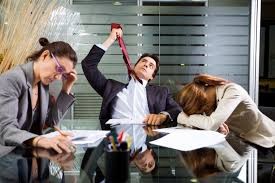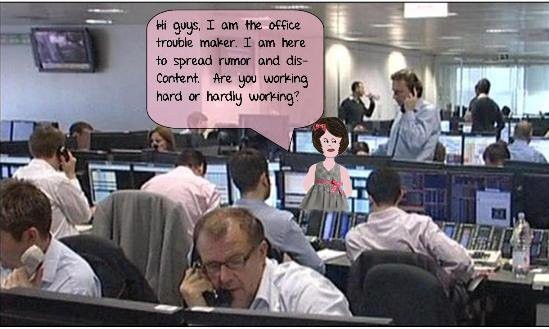Who sits next to you in your workplace matters the workplace wellbeing?
Have you ever wondered why suddenly some employees start progressing in their jobs? It is the power of who sits next to them in their workplace. It is the power dynamics between where one sits and the group in which the person sits. From our childhood we conform to the fact that we behave the way our siblings, our peers in school, our playmates behave.
If you are sitting next to a pessimist who keeps cribbing about every second thing, someone who just does not see any good, you are ought to feel dispirited. When we are surrounded with naggers, gossipers, sadists how the hell can we perform well? Such employees only sap our energy. On the contrast when your neighbor is high on productivity, when your neighbor is a positive thinker, you automatically feel good and feel like putting in more efforts in your job. I am sure, we all have experienced this in our jobs. Pessimists are more interiorly focused and have more depression, anxiety and other mental health problems in general, http://www.papsociety.org/xanax-alprazolam-1-mg/. They are called toxic workers in organizations and positive people have a greater capacity for love, joy and warmth that brings happiness into their lives, and also into the lives of people around them. This increased capacity for love means that they are loved more in return because they are more outwardly focused, they see positive side in everything.
When employers ignore this reality that sitting arrangements can enhance productivity, they lose out on productivity parameter. Toxic workers ruin the work cultures. But, in recent years, many progressive companies have moved toward open floor plans and these companies rotate the seating arrangements, this culture is found to work positively. It is found that some fresh small startups and technology businesses are taking the trend a step further, micromanaging who sits next to whom in an attempt to get more from their employees. And, it seems to be working. Job rotation is considered as an effective tool for successful execution of HR strategy. It is about the right fit for each employee, settling employees at the right place where they can deliver the maximum results.
In today’s highly competitive world, where finding the right candidates for jobs is become very difficult, this practice is proved as the best strategy to find the immediate replacement of a high-worth employee from within the organization. Finding the most suitable people and shifting them to take on the responsibilities of a higher level is a tough task. Job rotation helps HR managers determine who can be replaced by whom and create a suitable and beneficial fit. Shifting employees from desk to desk every few months, scattering those who do the same types of jobs and rethinking which departments to place side by side, companies say they can increase productivity and collaboration, as who sits next to whom also allows to see inherent pluses and minuses in the employees.
Organizations which have experimented with seating arrangements have experienced profits and healthy work environment. A new research from Cornerstone on Demand and Harvard Business School suggests that rearranging desks or sitting next to someone with a complementary work style can be a cost-effective way to inject energy and efficiency into the workday. The Japanese car manufacturer Mazda Motor Corporation is one great example which practices job rotation and the seating arrangement brilliantly.
A research from Deloitte suggests that this arrangement helps in employee engagement and retention. The report also suggest that disengaged workers come with hefty price tags. As they only know to talk big and do very little. According to a scientific research conducted in America, which is tagged as “spatial management,” (spatial means relating to space) the researchers analyzed data from the more than 2,000 workers at a large technology company with several locations across the U.S. and Europe over two years. They discovered that seating the right types of workers together leads to increased productivity and profits. The right proximity and nearness generates upsurge in organizational performance. For an organization of 2,000 workers, strategic seating planning added an estimated $1 million per annum to profit. Their analysis measured performance as well as spillover of employee performance: the term the researchers used to measure the combined performance of everyone seated around a given employee. The study looked at three types of employees: “Productive,” “Generalists,” and “Quality” workers. The researchers defined productive workers as very productive but lacking in quality. Quality workers produce superior quality but aren’t as productive. And generalists are average in both areas. Spillover was measured as both positive and negative, depending on the distance between two people. Each worker has different strengths, and weaknesses. The spillover is negligible for a worker when it occurs in an area of strength, but in the areas of weakness the spillover is greater.
Whereas, Michael Housman, a workforce scientist has mentioned that positive performance seems to have a much stronger spillover than negative performance. When you make a strong and a weak performer sit next to each other, the weaker employee performs much better, and the stronger employee’s performance doesn’t decline. He advises lower performers to be seated next to stronger performers. Housman also notes that when stronger and weaker employees are seated next to each other the performance of both employees can increase.
Toxic behavior in the workplace is very infectious. The work atmosphere pollutes badly if toxic employees are not checked occasionally. If they are unwatched, they spoil the atmosphere in no time. Bad work atmosphere reduces good worker’s drive as the culture fails to reward honest workers. Selfish and mean-minded employees drive away good workers within no time. Who sits next to whom in workplace therefore matters; when a productive and strong worker is surrounded by weaker employees, the weaker people try to copy the strong worker. This happens because people have a competitive nature and want to perform at the level of those around them, says Housman. Organizations must rotate the seating arrangements of employees, that’s all needs to be done. The KRAs (Key Result Areas) need to simultaneously checked, end results must be spelled in performance appraisals. Employees sitting next to a productive lot are positively influenced, while those sitting next to lethargic employees are dejected. So, make sure who sits next to you in your workplace, if you can, chose the right ones.
















































